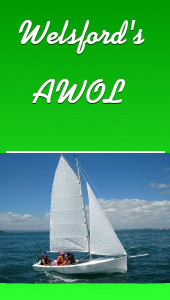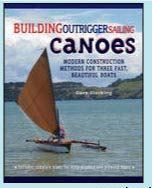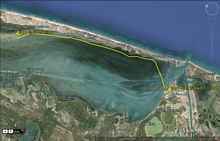Part 1
part 1 - part 2 - part 3 - part 4 - part 5 - part 6
The fearless driver of the 18 wheeler I am drafting behind doesn’t seem at all concerned about the construction here on I-35. Neither am I, although after a couple of energy drinks it sometimes feels like my brain is not connected to my eyes. We drive south together for hours, but finally something has to give. 20 miles south of San Antonio, I pull off the road behind some construction barriers, turn off the engine, and am asleep in just a couple of minutes.
I had tried to row the Texas 200 the previous year and failed, pulling out on the 4th day. When I first conceived the idea, I contacted Al Freihofer, who had rowed 452 miles along the East coast and had written about that adventure in Messing About in Boats. One thing we discussed at length was mental preparedness. I thought I was good to go, but sadly this was not the case.
 |
Lunch stop Day 1 |
 |
Wind and waves Day 1 |
I was well prepared with navigation planning, plenty of food and water, sun protection, and safety gear, but I did not push myself hard enough in training to get to the wall or the bonk. I really thought that I had this thing licked. I was good for 10-15 miles in training, but this was not enough, especially given the wind and waves I would encounter.
 |
Andy and Rick after a long rough day in their 8’ long Puddle Ducks. |
 |
Crews “Embracing the Suck” of a hard first day. |
For most of the third day the wind was hard, solid and unrelenting on my stern starboard quarter. The third afternoon I gave up on reaching camp and spent the night on Shamrock Island. I could not face the waves and wind in Corpus Christi Bay. Physically I was unprepared for all of the extra effort it took just to keep the skiff tracking. I estimate that I used 1/3 to 1/2 of each stroke to compensate for the wind. On the morning of the 4th day, I was worn out. I looked long and hard at the charts. Do I pull out in Port Aransas, or press on and face the unknown? I was tired, sore and unsure how long I could keep going. I opted for the former.
The wind was higher than I had hoped that morning as I struck camp and headed into the bay. It was overcast with low morning haze all around. Using the chart and compass I aimed dead on toward the gap between Pelican Island and the island to the west. Running downwind, there were times I couldn't see over the waves. The land on the horizon disappeared completely more than once. I knew that I was coming up on an area with lots of wellheads and began to get cautious, but the wave heights were increasing and boat was starting to surf. I will never forget the feeling when I caught THAT wave. It was like when you're body surfing and it just keeps going on and on. I stayed on that wave for probably a hundred yards. Amazed and giddy, I put the oars back in and started to pull. I scraped the sandy bottom about a foot down. I had caught the wave as it was getting shallow and the wave stayed connected with me on it, until its energy was spent shallowing up. When I looked around at the surroundings and my charts, I was exactly where I needed to be. Cool. I asked a fisherman for directions to a marina and found it then caught a ride from a local to Maggie Beach.
I lost at the mental game in 2014, but was committed to trying again. This time I knew what to expect. I knew what I had to push through, and knew the first 100 miles of the route by sight. I would face everything and adapt. No matter how hard it seemed, I knew it was a small effort compared to what Al Friehoffer had done. I spent many hours reviewing the route on Google Earth and poring over John Alesch’s excellent chart - aerial photos. It was much easier relating water color and land forms after having seen it from 4’ above the water. Every day I visualized the trip as I went through my daily routine. I got the boat in the water on White Rock Lake (a great place to train) and rowed at every opportunity. Most of the needed gear I had from last year, although this year I added a marine radio and waterproof video camera.
On Friday morning about 10:30am I finally pull into Port Isabel after the 12 hour drive from Mesquite. The fleet leaves on Monday, but I learned last year that a rowboat needs a head start. I load the boat, put her in the water, change clothes, and I’m off. The Laguna Madre is waiting.
Here We Go Again
By the early afternoon I am in the middle of the Mother Lagoon. The waves are large and the wind is strong, but the new skeg is helping tremendously with tracking. About a third of the way out the water is clearing and a round grey thing bobs up next to the stern. When I pull on the oar, it disappears. This thing looks like a semi submerged bowling ball with one eye and I wonder for hours what it is. I don’t figure it out until months after the trip when I run across an article (with pictures) about the Dolphin Lady of Port Isabel in Texas Parks and Wildlife Magazine. I have never before seen a picture of the back of a dolphin’s head. Mystery solved.
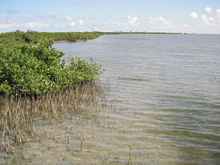 |
 |
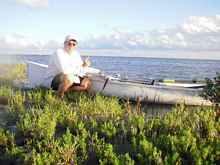 |
Winds are around 15, but the water is clear, and the waves shallow. My plan of hugging the barrier islands to stay out of the worst of the waves is working. Birds are everywhere. I see a caracara, also known as the Mexican Eagle, when I stop for lunch. As the afternoon wears on, the condos and other structures on South Padre Island slowly disappear behind me. After 6 hours of rowing I select a small sand island and row up to the beach. I set out the chair, table, and Jetboil, and realize that once I stop moving that I am slowly sinking into the sand, so after a quick dinner I make up the boat for sleeping. As the mosquitoes make their appearance at dusk, I lay my scrubs and shirt out on some bushes to dry, and slip under the nets for the night. I am lulled into a deep and satisfying sleep by the growling, squeaking, and whining sounds of the local shorebirds.
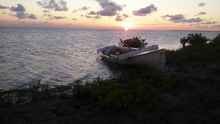 |
End day 1 |
to be continued...
|



